The Love Triangle Spread
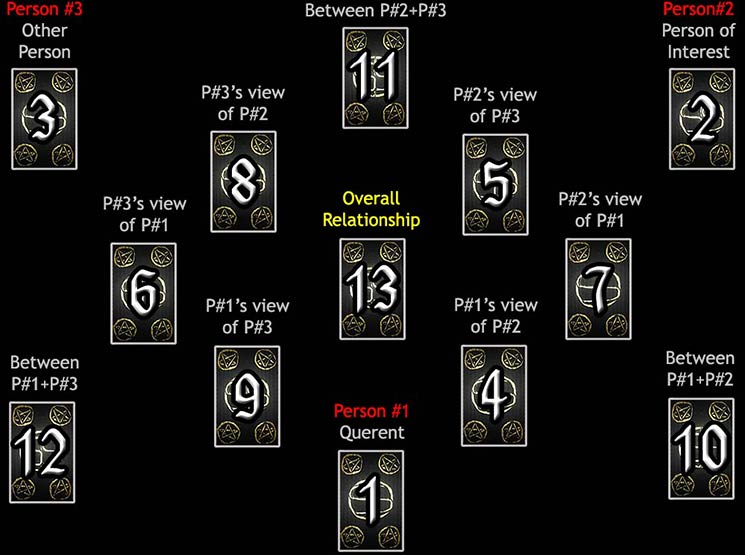
Difficulty: Complicated
Casually referred to as the Love Triangle, this spread can be used to determine the dynamics of the relationship between three people, regardless of whether romance is involved. This spread is arranged in the form of a hexagram, consisting of several large and small triangles. This tarot spread may seem somewhat complicated, but it is not entirely that difficult.
The first step is to interpret the card for each individual position in the spread. Generally, one might ask about a relationship they are involved in, but this does not have to be the case. Ordinarily, the reader's representative card is #1, their main person of interest is #2, and the other person would be #3.
The second step fills in the downward triangle and involves further examination of the individuals through their views of the other people. Each person has two more cards showing the way they see and relate to the other members of the triangle. For example, Card #6 indicates how Person #3 relates to Person #1, while Card #9 stands for Person #1's attitude toward Person #3.
The next step completes the upward triangle and the hexagram, focusing on cards #10–13. It also completes the many smaller triangles and hints at the potential for each relationship. The final card, #13 can be considered the significator of the reading, which suggests the overall potential for this three-way relationship.
Your Love Triangle Reading
| P#3 | 3to2 | 2+3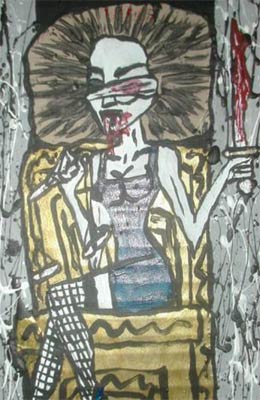 |
2to3 | P#2 | ||
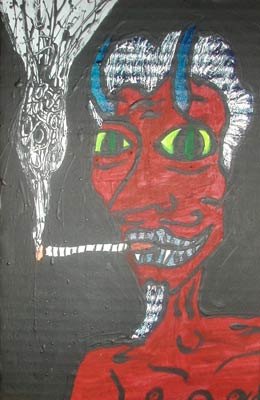 |
3to1 | 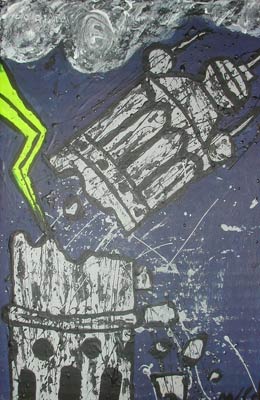 |
Overall |  |
2to1 | 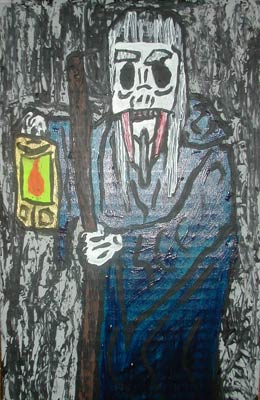 |
| 1+3 | 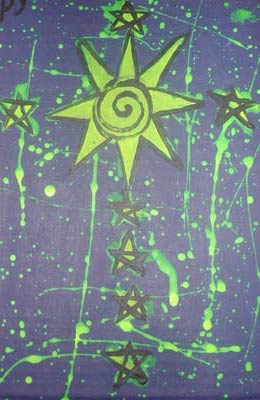 |
1to3 |  |
1to2 | 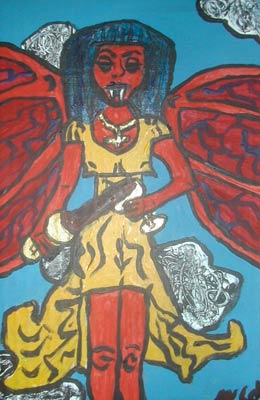 |
1+2 |
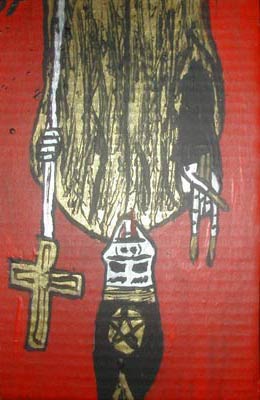 |
 |
P#1 | 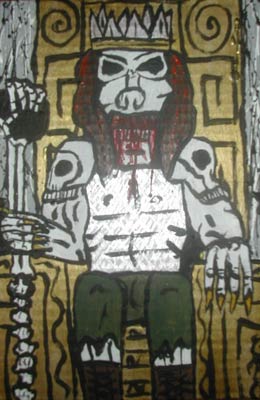 |
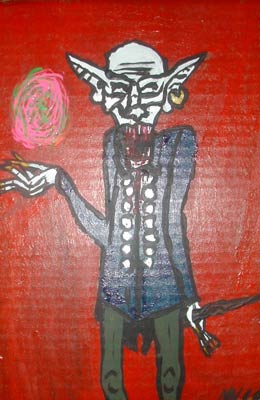 |
||
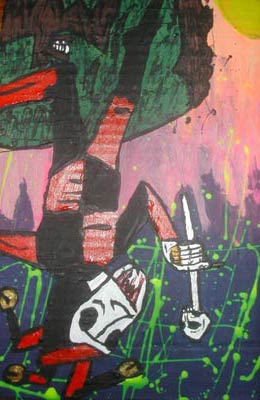 |
1: Person #1

Reversed
Symbolism:
The Fool is depicted as a pale, ethereal figure walking a misty, crumbling path, a bundle tied to a staff slung over their shoulder. They gaze skyward, unaware of the jagged cliff at their feet. A spectral wolf follows close behind, snarling a silent warning. Overhead, a full moon illuminates their journey, hinting at the mystery and potential of new beginnings. In their hand, a delicate white rose symbolizes innocence and purity.
Meaning:
The Fool represents beginnings, spontaneity, and boundless potential. It urges you to take a leap of faith, trusting in the journey ahead. While the path may be uncertain, embracing the unknown opens the door to growth, discovery, and self-expression.
Reversed, the Fool warns of recklessness, naivety, or hesitation. It suggests the need to pause and consider potential consequences before plunging ahead.
Keywords:
Reversed: Recklessness, foolishness, naivety, hesitation, fear of the unknown, poor judgment.
2: Person #2

Symbolism:
The Hermit is depicted as an ancient vampire cloaked in tattered robes, holding a lantern that emits an eerie, bluish glow. He stands atop a desolate mountain peak, surrounded by swirling mist. The lantern's light reveals faint traces of hidden paths, while his posture suggests quiet contemplation. The darkness around him symbolizes isolation, while the light represents the wisdom gained through introspection.
Meaning:
The Hermit signifies solitude, introspection, and the search for deeper truths. He encourages stepping back from external distractions to seek clarity and wisdom within. This card often appears when you need time alone to reflect on your journey or make decisions based on your inner guidance. It may also indicate the guidance of a mentor or wise figure.
Keywords:
Upright: Introspection, solitude, wisdom, self-reflection, spiritual journey, guidance.
3: Person #3

Symbolism:
The Devil is portrayed as a towering, horned figure shrouded in shadow, with glowing crimson eyes and skeletal bat wings. Chains dangle from its outstretched hands, tethered to two figures who appear entranced rather than distressed, symbolizing voluntary bondage. A fiery pit burns at its feet, while the moon above is obscured by dark clouds, representing ignorance and illusion. Behind the Devil, a cracked mirror reflects hidden desires and fears.
Meaning:
The Devil signifies temptation, materialism, and self-imposed limitations. It highlights the darker aspects of human nature, such as obsession, addiction, or unhealthy attachments. This card often serves as a wake-up call to recognize and confront these influences, reclaiming your power and freedom.
Keywords:
Upright: Temptation, bondage, addiction, materialism, obsession, illusion, control.
4: Person #1's view of #2

Symbolism:
The Emperor is a Nosferatu seated on a blood-soaked throne, gripping the Hand of Glory as his scepter of authority. His crimson cloak flows like a river of lifeblood, symbolizing his dominion over life and death. Behind him, a craggy fortress rises, representing stability and the structures of power. His stern, commanding gaze reinforces his role as a protector and enforcer of order.
Meaning:
The Emperor symbolizes authority, stability, and protection. He represents the need for structure and discipline to achieve goals and maintain order. As a figure of leadership, he encourages reason and conviction in decision-making. This card often indicates a time to take control of your environment or to rely on a strong, supportive figure for guidance.
Keywords:
Upright: Authority, stability, protection, leadership, discipline, order, reason.
5: Person #2's view of #3

Reversed
Symbolism:
The Hanged Man is shown suspended upside-down from a barren tree, his foot bound by a chain of silver. His expression is serene, as if willingly surrendering to his predicament. A pool of crimson liquid forms beneath him, reflecting a full moon, symbolizing surrender and the potential for transformation. Surrounding him, shadows twist into shapes of wings, hinting at the freedom that comes through letting go.
Meaning:
The Hanged Man represents surrender, perspective, and the need to pause. It encourages you to let go of control and view a situation from a different angle. This card often signals a period of waiting or self-sacrifice, where stepping back can lead to greater understanding or personal growth.
Reversed, the Hanged Man warns of resistance to change, stagnation, or clinging to outdated perspectives. It may suggest the need to take decisive action after prolonged inaction.
Keywords:
Reversed: Resistance, indecision, stagnation, delay, refusal to see another perspective, avoidance.
6: Person #3's view of #1

Reversed
Symbolism:
The Star depicts a luminous vampire bathing in a moonlit pool, her pale skin shimmering with starlight. She pours blood from a goblet into the water, symbolizing renewal and the cycle of life. Above her, a constellation forms the shape of a chalice, representing hope and inspiration. The night sky is clear, and the surrounding landscape, though desolate, begins to show signs of new growth.
Meaning:
The Star embodies hope, inspiration, and spiritual renewal. It encourages you to trust in the universe and your own inner light, even during challenging times. This card often appears after a period of struggle, signaling healing, clarity, and the promise of brighter days ahead.
Reversed, the Star warns of doubt, pessimism, or a loss of direction. It may suggest the need to reconnect with your dreams or rekindle your faith in the future.
Keywords:
Reversed: Doubt, despair, loss of faith, disconnection, hopelessness, lack of direction.
7: Person #2's view of #1

Symbolism:
Temperance is represented by a vampiric figure gracefully pouring a stream of crimson liquid from one chalice into another, symbolizing balance and harmony. She stands with one foot in a dark pool and the other on solid ground, representing the interplay between emotion and reason. Her wings are half-feathered, half-batlike, indicating the union of opposing forces. The background shifts between twilight and dawn, underscoring equilibrium.
Meaning:
Temperance embodies balance, moderation, and the harmonious blending of opposites. It encourages patience and the careful integration of different aspects of your life. This card often suggests the need for self-restraint, collaboration, or finding common ground in a situation.
Keywords:
Upright: Balance, harmony, moderation, patience, integration, adaptability, calm.
8: Person #3's view of #2

Symbolism:
The Tower is shown as a crumbling gothic spire, struck by lightning and engulfed in flames. Figures are seen falling from the heights, their faces contorted in shock and despair. The dark sky above swirls with storm clouds, while the ground below splits open, exposing molten lava. Amid the destruction, a single raven perches on the rubble, symbolizing the potential for renewal through upheaval.
Meaning:
The Tower represents sudden upheaval, revelation, and the breaking down of false structures. It signals a dramatic, often unexpected event that shakes the foundations of your life, forcing you to confront harsh truths. While challenging, this card ultimately clears the way for genuine growth and transformation.
Keywords:
Upright: Upheaval, revelation, chaos, destruction, truth, transformation, awakening.
9: Person #1's view of #3

Reversed
Symbolism:
Judgment depicts a haunting scene of the dead rising from crypts bathed in an eerie, silvery glow. A vampire angel hovers above, blowing a trumpet, its sound visible as luminous, curling waves. The figures below lift their arms skyward, drawn by the call to awakening. A massive, ancient tree stands in the background, its roots tangled with bones, symbolizing the cyclical nature of life and death.
Meaning:
Judgment signifies renewal, self-assessment, and a call to rise above the past. It asks you to confront your actions, choices, and truths, encouraging accountability and forgiveness. This card often appears during moments of profound transition, marking the opportunity to shed old burdens and embrace a higher purpose.
Reversed, Judgment warns of self-doubt, avoidance, or fear of change. It suggests a resistance to growth or ignoring the need for reflection.
Keywords:
Reversed: Self-doubt, avoidance, fear of change, lack of reflection, denial, stagnation.
10: Overall relationship between persons #1 and #2

Symbolism:
The Magician is depicted as a Nosferatu vampire standing in a commanding pose, a sphere of influence hovering above his outstretched hand. This sphere glows with an otherworldly light, symbolizing his power to manipulate unseen forces. His posture exudes confidence, and the tools of his craft—representing the elements—are subtly embedded in the imagery, hinting at his mastery over earth, air, fire, and water. The shadows around him pulse with potential, representing untapped energy and possibility.
Meaning:
The Magician embodies willpower, creativity, and the ability to manifest one's desires. He is the ultimate initiator, reminding you that you have the power within to transform ideas into reality. This card urges action and focus, calling upon the seeker to harness their innate talents and take charge of their destiny. In situations requiring ingenuity or problem-solving, the Magician assures you that all the tools you need are at your disposal.
Keywords:
Upright: Initiative, willpower, manifestation, skill, confidence, resourcefulness, creation.
11: Overall relationship between persons #2 and #3

Symbolism:
Justice is depicted as a pale, vampiric figure holding a pair of scales in one hand and a blood-stained sword in the other. One side of the scale holds a black feather, while the other holds a human heart, symbolizing the balance between moral accountability and emotional truth. Her blindfold is sheer, hinting at impartiality tempered with insight. Behind her, a blood-red curtain reveals fragmented mirrors reflecting distorted truths.
Meaning:
Justice embodies fairness, truth, and accountability. She calls for honesty and objectivity in your actions and decisions, ensuring that you consider all perspectives before rendering judgment. This card often signals the need to weigh your choices carefully and to take responsibility for the consequences of past actions.
Keywords:
Upright: Fairness, truth, accountability, integrity, balance, objectivity, karma.
12: Overall relationship between persons #1 and #3

Reversed
Symbolism:
The Hierophant stands in a candlelit crypt, robed in dark ceremonial attire. His face is obscured by a mask resembling a skull, emphasizing his role as a mediator between the living and the dead. In his hands, he holds an ancient grimoire, its pages glowing faintly as if infused with sacred knowledge. Behind him, shadowy figures bow in reverence, symbolizing tradition and the transfer of esoteric teachings.
Meaning:
The Hierophant represents tradition, spiritual guidance, and conformity to established systems of belief. He serves as a bridge between the divine and the mundane, reminding you to honor time-tested wisdom and moral values. This card often calls for introspection about your relationship with tradition and how it shapes your choices. It may also suggest seeking counsel or mentorship from someone with greater experience or spiritual authority.
Reversed, the Hierophant challenges the rigidity of traditions, encouraging independent thought and nonconformity. It warns against blind faith in systems that may no longer serve you.
Keywords:
Reversed: Nonconformity, rebellion, outdated beliefs, spiritual doubt, dogmatism.
13: Overall 3-way Relationship

Symbolism:
The World depicts a powerful figure standing within a glowing circle of blood-red roses, symbolizing completion and unity. The four corners of the card feature elemental creatures: a bat, a wolf, a raven, and a serpent, representing balance and harmony among all forces. A starry night sky stretches infinitely behind the figure, while they hold a silver orb and a golden key, symbolizing mastery and fulfillment.
Meaning:
The World represents completion, fulfillment, and the achievement of long-term goals. It signifies harmony, wholeness, and the realization of your place in the greater tapestry of existence. This card often marks the end of a significant journey, celebrating your success and inviting you to share your gifts with others.
Keywords:
Upright: Completion, fulfillment, harmony, success, unity, wholeness, achievement.
